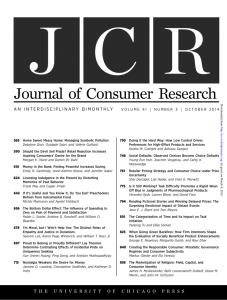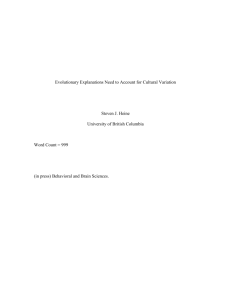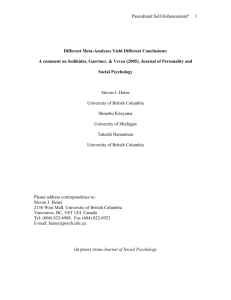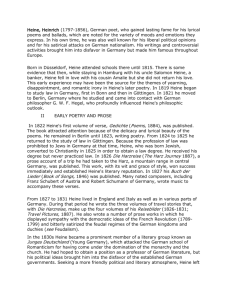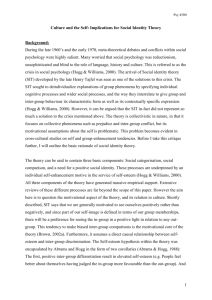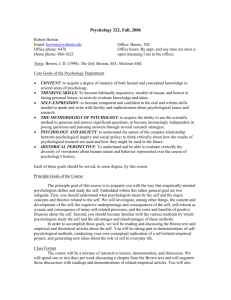Which Studies Test Whether Self
advertisement
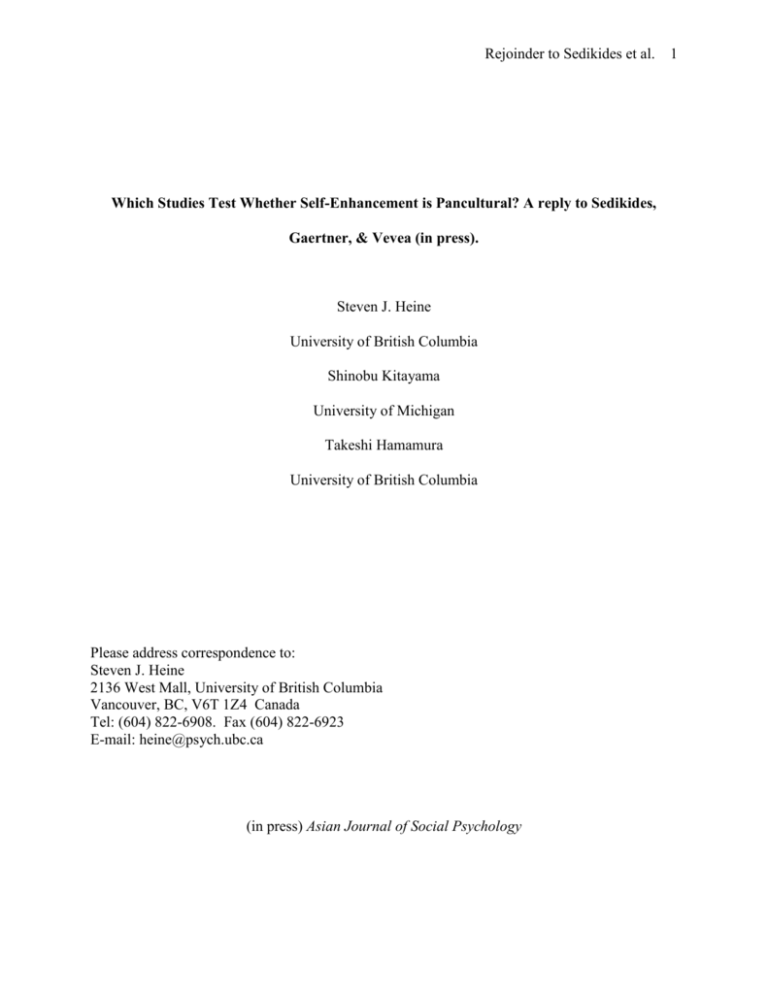
Rejoinder to Sedikides et al. Which Studies Test Whether Self-Enhancement is Pancultural? A reply to Sedikides, Gaertner, & Vevea (in press). Steven J. Heine University of British Columbia Shinobu Kitayama University of Michigan Takeshi Hamamura University of British Columbia Please address correspondence to: Steven J. Heine 2136 West Mall, University of British Columbia Vancouver, BC, V6T 1Z4 Canada Tel: (604) 822-6908. Fax (604) 822-6923 E-mail: heine@psych.ubc.ca (in press) Asian Journal of Social Psychology 1 Rejoinder to Sedikides et al. 2 Abstract What kinds of studies test the question of pancultural self-enhancement? Sedikides et al. (in press) have identified inclusion criteria that largely limit the question to studies of the betterthan-average effect (i.e., 27 out of 29 effects that they include as “validated” and “relevant”). In contrast, other effects which they labeled as “unvalidated” or “irrelevant” utilized methods other than the better-than-average effect (i.e., 24 out of 24 effects). Because Sedikides et al. (in press) are drawing conclusions about pancultural self-enhancement and not the pancultural better-thanaverage effect these excluded studies are relevant to the hypothesis under question. Ignoring the findings from other methods is highly problematic, in particular because these other methods yield results that conflict with those from the better-than-average effect. An analysis of effects from all studies reveals no support for pancultural self-enhancement. Rejoinder to Sedikides et al. 3 We appreciate this opportunity to respond to Sedikides, Gaertner, and Vevea’s (in press) reply to our comment (Heine, Kitayama, & Hamamura, in press) on their response (Sedikides, Gaertner, & Vevea, 2005) to Heine’s rejoinder (Heine, 2005) to Sedikides, Gaertner, and Toguchi’s (2003) challenge to our original paper (Heine, Lehman, Markus & Kitayama, 1999) that questioned the universality of the self-enhancement motive. We are pleased to see that the analyses from the 6 key papers of contention (Heine, Kitayama, Lehman, Takata, Ide, Leung, & Matsumoto, 2001; Heine & Lehman, 1995, 1999; Heine & Renshaw, 2002; Kitayama, Markus, Matsumoto, & Norasakkunkit, 1997; Markus & Kitayama, 1991) that two of us have worked on to address the question of pancultural selfenhancement are now included in the Sedikides et al. (in press) meta-analyses on this topic. However, we dispute the criteria that they use to determine which studies are appropriate to test the question of pancultural self-enhancement. A perusal of the effects from Tables 1 and 3 of Sedikides et al.’s (in press) meta-analyses yields two sets of findings. One set is largely consistent with their hypotheses regarding pancultural self-enhancement, and finds Westerners self-enhancing more on individualistic than collectivistic dimensions, and East Asians self-enhancing more for traits that they view to be especially important. The other set largely reveals the precise opposite pattern: Westerners selfenhancing less on individualistic than collectivistic dimensions and East Asians self-enhancing less for traits that they view to be especially important. Sedikides et al (in press) deem the vast majority of the studies in this latter set to be “unvalidated” or “irrelevant” to the question of pancultural self-enhancement and these studies are ignored in the conclusions that they draw. What studies are relevant to the question of pancultural self-enhancement? We submit that Sedikides et al.’s (in press) criteria for what entails self-enhancement are unique to the field, Rejoinder to Sedikides et al. 4 and are dubious in validity. According to their inclusion criteria, the only acceptable measures of self-enhancement are those studies that “provide a measure of self vs. other perception.” What this means is that 27 of the 29 effects that Sedikides et al. (in press) considered to be “validated” and “relevant” are measures of the better-than-average effect (see Heine & Hamamura, 2007; Hamamura, Heine, & Takemoto, 2007), whereas 24 of the 24 effects that they considered to be “unvalidated” or “irrelevant” employed measures other than the better-thanaverage effect. Furthermore, Sedikides et al. (in press) only included 4 of the 8 effects from Hamamura et al., (2007) in Table 3. The other 4 effects are for some reason excluded, and it is worth noting that these effects both would seem to meet their criteria of relevance and do not support pancultural self-enhancement. It is problematic to limit a meta-analysis to survey the results from largely one method, when there are dozens of different operationalizations of selfenhancement (we identified 30 in a recent meta-analysis of cross-cultural studies; Heine & Hamamura, 2007). Their criteria are even more questionable as there is a growing chorus of voices that there is something problematic with using the better-than-average effect as a measure of self-enhancement as the measure implicates various non-motivational mechanisms that are not included in other measures of self-enhancement (e.g., Chambers & Windschitl, 2004; Klar & Giladi, 1997; Kruger, 1999; Kwan, John, Kenny, Bond, & Robins, 2004). But their criteria strike us as most insupportable because the studies that use other designs yield the opposite pattern of findings with respect to the question of pancultural self-enhancement as that found with the BAE (see Heine et al., in press). Rather than discuss this contrary set of findings, or offer explanations why they might yield a different pattern, Sedikides et al. (in press) offer the conclusion that these studies can be labeled irrelevant to the question of pancultural selfenhancement, and can be ignored, as they have done in their previous papers. Elsewhere, we Rejoinder to Sedikides et al. 5 offer an explanation and empirical evidence (Hamamura et al., 2007; Heine, 2005), to account for the findings from all the studies in the meta-analyses. In sum, we conclude that self-enhancement is a far broader phenomenon than that encapsulated by the very narrow inclusion criteria used by Sedikides et al. (in press). This is problematic if they wish to conclude, as they do, that their meta-analyses demonstrate support for pancultural self-enhancement, and not the pancultural better-than-average effect. In their Appendix, Sedikides et al. (in press) offer arguments regarding why the 6 papers in contention do not meet their inclusion criteria, however, in none of their papers do they ever discuss why pancultural self-enhancement can only be tested with such criteria. Inclusion criteria for metaanalyses must be consistent with the conclusions that are drawn, and Sedikides et al.’s (in press) inclusion criteria are at odds with their conclusions regarding pancultural self-enhancement. We invite readers to read the various studies that were excluded for being unvalidated or irrelevant and decide for themselves whether these address the question of pancultural self-enhancement. We contend that when you look at all the studies that have investigated this question, as we did in Heine et al. (in press), there is no support for the notion that East Asians tactically selfenhance on dimensions that are important to them. Rejoinder to Sedikides et al. 6 References Chambers, J. R., & Windschitl, P. D. (2004). Biases in social comparative judgments: the role of nonmotivated factors in above-average and comparative-optimism effects. Psychological Bulletin, 130, 813-838. Hamamura, T., Heine, S. J., & Takemoto, T. (2006). Why the Better-than-Average Effect is a worse-than-average measure of self-enhancement. An investigation of conflicting findings from studies of East Asian self-evaluations. Manuscript under review. University of British Columbia. Heine, S. J. (2005). Where is the evidence for pancultural self-enhancement?: A reply to Sedikides, Gaertner, and Toguchi (2003). Journal of Personality and Social Psychology, 89, 531-538. Heine, S. J., & Hamamura, T. (2007). In search of East Asian self-enhancement. Personality and Social Psychology Review, 11, 1-24. Heine, S. J., Kitayama, S., & Hamamura, T. (in press). The inclusion of additional studies yields different conclusions: A reply to Sedikides, Gaertner, & Vevea (2005), JPSP. Asian Journal of Social Psychology. Heine, S. J., Kitayama, S., Lehman, D. R., Takata, T., Ide, E., Leung, C., & Matsumoto, H. (2001). Divergent consequences of success and failure in Japan and North America: An investigation of self-improving motivations and malleable selves. Journal of Personality and Social Psychology, 81, 599-615. Heine, S. J., & Lehman, D. R. (1995). Cultural variation in unrealistic optimism: Does the West feel more vulnerable than the East? Journal of Personality and Social Psychology, 72, 1268-1283. Rejoinder to Sedikides et al. 7 Heine, S. J., & Lehman, D. R. (1999). Culture, self-discrepancies, and self-satisfaction. Personality and Social Psychology Bulletin, 25, 915-925. Heine, S. J., Lehman, D. R., Markus, H. R., & Kitayama, S. (1999). Is there a universal need for positive self-regard? Psychological Review, 106, 766-794. Heine, S. J., & Renshaw, K. (2002). Interjudge agreement, self-enhancement, and liking: Crosscultural divergences. Personality and Social Psychology Bulletin, 28, 578-587. Kitayama, S., Markus, H. R., Matsumoto, H., & Norasakkunkit, V. (1997). Individual and collective processes in the construction of the self: Self-enhancement in the United States and self-criticism in Japan. Journal of Personality and Social Psychology, 72, 1245-1267. Klar, Y., & Giladi, E. E. (1997). No one in my group can be below the group’s average” A robust positivity bias in favor of anonymous peers. Journal of Personality and Social Psychology, 73, 885-901. Kruger, J. (1999). Lake Wobegon be gone! The “below-average effect” and the egocentric nature of comparative ability judgments. Journal of Personality and Social Psychology, 77, 221232. Kwan, V. S. Y., John, O. P., Kenny, D. A., Bond, M. H., & Robins, R. W. (2004). Reconceptualizing individual differences in self-enhancement bias: An interpersonal approach. Psychological Review, 111, 94-111. Markus, H. R., & Kitayama, S. (1991). Cultural variation in the self-concept. In G. R. Goethals & J. Strauss (Eds.), Multidisciplinary perspectives on the self (pp. 18-48). New York: Springer-Verlag. Sedikides, C., Gaertner, L., & Toguchi, Y. (2003). Pancultural self-enhancement. Journal of Personality and Social Psychology, 84, 60-70. Rejoinder to Sedikides et al. 8 Sedikides, C., Gaertner, L., & Vevea, J. L. (2005). Pancultural self-enhancement reloaded: A meta-analytic reply to Heine (2005). Journal of Personality and Social Psychology, 89, 539-551. Sedikides, C., Gaertner, L., & Vevea, J. L. (in press). The inclusion of theory-relevant moderators yield the same conclusions as Sedikides, Gaertner, and Vevea (2005): A meta-analytic reply to Heine, Kitayma, and Hamamura (in press). Asian Journal of Social Psychology.
